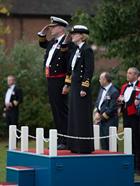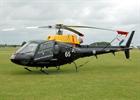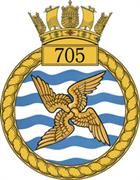Marking 75 years of naval flying excellence
Instuctors and students at 705 Naval Air Squadron are celebrating the unit’s 75th anniversary.
A Royal Naval Air Squadron celebrated its 75th Anniversary with a special cocktail party at RAF Shawbury.
The event was held in the Officers’ Mess, which was decorated with displays of the Second World War history of the Squadron, kindly exhibited by the Fleet Air Arm Museum.
705 NAS was formed during World War 2 and originally operated Swordfish torpedo bombers from battlecruisers.
Since the 1950s the Squadron has been involved in training helicopter aircrew and currently forms part of the Defence Helicopter Flying School at RAF Shawbury in Shropshire.
Currently boasting an outstanding cadre of 21 instructors from all three services, with more than 75,000 flying hours between them, the squadron is as vibrant now as it ever has been.
The celebration was attended by former and serving members of 705 NAS, their partners and guests. Guest of honour was Vice-Admiral Alan Richards, Chief of Defence Intelligence.
The guests were entertained by the Shawbury Military Wives Choir and the RAF Cosford Volunteer Band. The guests were then invited outside to enjoy a Sunset Ceremony and flypast by three Squirrel helicopters with a Royal Naval Wildcat helicopter in trail.
Lt Cdr Becky Frater, Officer Commanding of 705, said: “Command is always a great privilege but never more so of 705 Naval Air Squadron at such a significant moment in it’s history.”
“It is absolutely wonderful that so many past members of 705 NAS have joined us to celebrate our 75th year including pilots, observers and aircrewmen from all corners of the Fleet Air Arm and UK. A particular thank you to our Guest of Honour, Vice Admiral Alan Richards, and the Commanding Officers of 824 Naval Air Squadron, 815 Naval Air Squadron, 825 Naval Air Squadron, the Lynx Wildcat Maritime Force and the Commandant of the Defence Helicopter Flying School for supporting this occasion.”
The Squadron was one of the first maritime helicopter squadrons in the world and carried out the first helicopter deck landing on a Royal Navy warship. 705 NAS also helped to pioneer many of the Search-and-Rescue tactics and procedures in place today.
The squadron, part of the Defence Helicopter Flying School at RAF Shawbury in Shropshire, is where all RN pilots are put through their paces.
“Students are under huge pressure, said Commanding Officer Lieutenant Commander Becky Frater. “We are not just assessing their flying but also their officer qualities; their personalities, every aspect of their character is examined every day.”
The former Black Cat display team pilot added: “705 is unique, its depth of heritage comes from flying training – every Royal Navy rotary pilot will have come through 705, therefore everyone has memories of 705.
“At 705 we have every Service and every aircraft represented in our instructors – a real depth and wealth of experience.
“DHFS is something I really champion. It sets an example to all three Services.
“The Fleet Air Arm is a tight-knit family and these wings badges are most prestigious, it is a wonderful thing to be in charge of.
“The Fleet Air Arm is experiencing a real renaissance, it has an air of excellence and whatever anyone else says, flying off a ship in the middle of the ocean is the hardest thing you can do in a helicopter.”
Lt Cdr Frater, 40, is one of 21 instructors – with 75,000 flying hours between them – charged with teaching students from all three Services in the Squirrel helicopter. The instructing staff includes three from the Army and five from the RAF.
Four classes a year go through Shawbury for the six-month courses, two at 705 and two at neighbouring 660 Squadron Army Air Corps.
The initial flying-training course teaches basic rotary-wing skills and emergency handling, including engine-off landings, culminating in a first solo and a handling check.
The next phase of the course is where basic skills are consolidated and developed into more applied techniques.
The syllabus includes non-procedural instrument flying, basic night flying, low-level and formation flying, mountain flying (at Snowdonia) and an introduction to winching for RN students.
It all culminates in a final handling test.
Lt Cdr Frater said: “Current and future students have a focus now on the new HMS Queen Elizabeth carrier. There are exciting times ahead.
“We are a long way from the sea, both physically and metaphorically as we are the first rung of the training process, but seeing people graduate is rewarding, although the real reward is seeing them get their wings.”
As well as the basic flying courses, a number of other, sometimes bespoke, courses are run, including certified to instruct; pilot refresher, UK orientation course for exchange students from the USA and Australia for example, and senior officers’ familiarisation courses.
705 also has three aircrewmen on the squadron who will be delivering a new advanced navigation module on the Joint Aircrewman Course (previously RN and the Army Air Corps ran separate training).
The JAC will also see the first direct-entry personnel into the RN and ACC, a move not seen since WW2.
Brief History of 705 NAS
705 Flight stood up in June 1936 and achieved squadron status three years later.
The flight operated Fairey Swordfish from the battlecruisers HMS Repulse and Renown.
In WW2 the squadron protected troop convoys on the North America and West Indies Stations.
Returning to RNAS Lee-on-the-Solent in Hampshire, the squadron was disbanded in 1940.
It was reformed in 1945 and recommissioned in 1947 at RNAS Daedalus, Gosport, flying the Sikorsky Hoverfly.
That year an instructor from 705 carried out the first helicopter deck landing on a Royal Navy Ship, HMS Vanguard.
705 NAS moved to RNAS Culdrose in the late 1950s, flying the Westland Dragonfly, the Hiller HT1 and the Sikorsky S55.
At Culdrose the later marks of Hiller and Whirlwind were flown.
The aircraft were replaced by the Westland Gazelle HT Mk2 in 1974.
Between 1975 and 1992, squadron instructors performed as the Sharks helicopter display team.
In April 1997, 705 NAS was disbanded and reformed at RAF Shawbury in Shropshire as part of the Defence Helicopter Flying School, flying the Eurocopter Squirrel HT Mk1.





